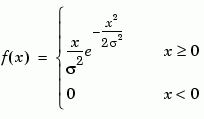

| Communications Blockset |   |
Generate Rayleigh distributed noise
Library
Noise Generators sublibrary of Comm Sources
Description 
The Rayleigh Noise Generator block generates Rayleigh distributed noise. The Rayleigh probability density function is given by

where  is known as the fading envelope of the Rayleigh distribution.
is known as the fading envelope of the Rayleigh distribution.
The block requires you to specify the Initial seed for the random number generator. If it is a constant, then the resulting noise is repeatable. The sigma parameter can be either a vector of the same length as the Initial seed, or a scalar. When sigma is a scalar, every element of the output signal shares that same value.
Initial Seed
The Initial seed parameter initializes the random number generator that the Rayleigh Noise Generator block uses to add noise to the input signal. For best results, the Initial seed should be a prime number greater than 30. Also, if there are other blocks in a model that have an Initial seed parameter, you should choose different initial seeds for all such blocks.
You can choose seeds for the Rayleigh Noise Generator block using the Communications Blockset's randseed function. At the MATLAB prompt, type the command
This returns a random prime number greater than 30. Typing randseed again produces a different prime number. If you add an integer argument, randseed always returns the same prime for that integer. For example, randseed(5) always returns the same answer.
Attributes of Output Signal
The output signal can be a frame-based matrix, a sample-based row or column vector, or a sample-based one-dimensional array. These attributes are controlled by the Frame-based outputs, Samples per frame, and Interpret vector parameters as 1-D parameters. See Signal Attribute Parameters for Random Sources in Using the Communications Blockset for more details.
The number of elements in the Initial seed parameter becomes the number of columns in a frame-based output or the number of elements in a sample-based vector output. Also, the shape (row or column) of the Initial seed parameter becomes the shape of a sample-based two-dimensional output signal.
Dialog Box
 as defined in the Rayleigh probability density function.
as defined in the Rayleigh probability density function.See Also
Multipath Rayleigh Fading Channel; raylrnd (Statistics Toolbox)
References
[1] Proakis, John G. Digital Communications, Third edition. New York: McGraw Hill, 1995.
 | Random Interleaver | Receiver Thermal Noise |  |